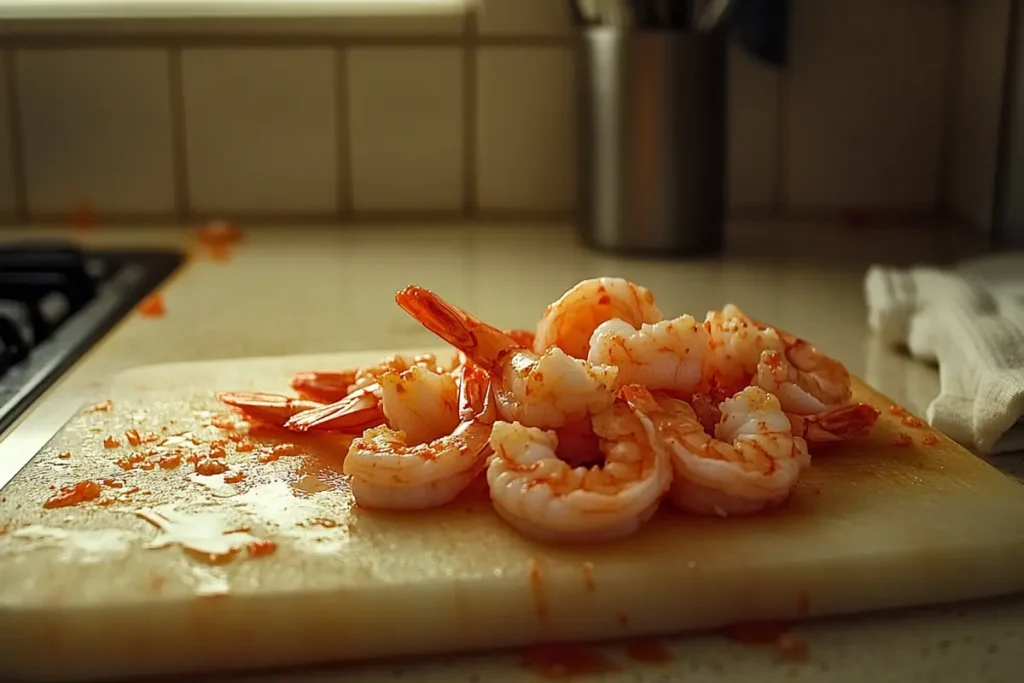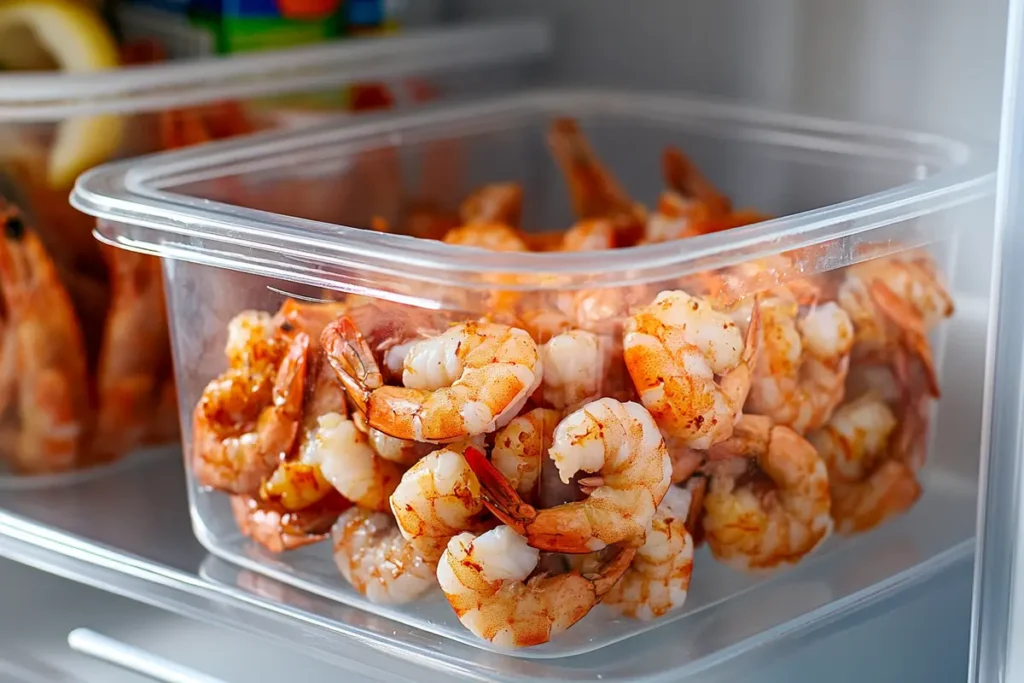Understanding Cooked Shrimp Safety
Shrimp is a delicate food that can spoil quickly if mishandled. Eating spoiled cooked shrimp not only ruins your meal but can also lead to foodborne illnesses. Understanding when should you not eat cooked shrimp is vital for maintaining your health and ensuring that every seafood experience is enjoyable.
What Are the Common Risks of Spoiled Cooked Shrimp?
Spoiled shrimp poses a significant risk to your health due to harmful bacteria like Vibrio and Salmonella. When cooked shrimp is stored improperly or left out too long, it can harbor pathogens that lead to serious conditions like nausea, diarrhea, and stomach cramps. For vulnerable groups, such as the elderly, children, and pregnant women, these risks are even greater.
How Long Does Cooked Shrimp Stay Fresh?
Cooked shrimp is best consumed within 3-4 days when refrigerated at or below 40°F (4°C). After this period, its quality begins to deteriorate. Freezing shrimp extends its shelf life, but even then, it’s important to follow proper thawing methods to ensure safety.” Revised sentence: “Freezing shrimp extends its shelf life, but even then, it’s important to follow proper thawing methods, much like understanding the secret to grilling shrimp.
Is Cooked Shrimp Safe If Left Out Overnight?
Unfortunately, no. Cooked shrimp that’s left out at room temperature for more than 2 hours falls into the “danger zone” of 40°F to 140°F (4°C to 60°C), where bacteria multiply rapidly. If you find cooked shrimp left out overnight, it’s best to discard it—no exceptions!
What Does Fresh Cooked Shrimp Look Like?
Nutritional Content of Cooked Shrimp (Per 100g)
| Nutrient | Amount | % Daily Value* |
|---|---|---|
| Calories | 99 kcal | 5% |
| Protein | 24 g | 48% |
| Total Fat | 0.3 g | 0% |
| Saturated Fat | 0.1 g | 0% |
| Cholesterol | 189 mg | 63% |
| Sodium | 111 mg | 5% |
| Potassium | 264 mg | 8% |
| Vitamin A | 50 IU | 1% |
| Calcium | 70 mg | 7% |
| Iron | 0.4 mg | 2% |
*Percent Daily Values are based on a 2,000-calorie diet. Your daily values may be higher or lower depending on your calorie needs.
Fresh cooked shrimp should have a bright pink color, firm texture, and mild oceanic smell. If your shrimp has a slimy coating, unusual odor, or appears discolored, these are red flags that it’s no longer safe to eat.
Why Some Shrimp Smell Stronger Than Others
Not all strong-smelling shrimp are spoiled, but an ammonia-like or sour odor is a clear sign of spoilage. Always trust your nose when determining shrimp quality. If something smells off, don’t take the risk.
Pro Tip: Spotting Shrimp Spoilage Before Consumption
Before indulging in cooked shrimp, always perform a quick check:
- Inspect for discoloration or gray spots.
- Feel for sliminess or mushy texture.
- Smell for any sour, rancid, or off-putting odors.
By following these steps, you’ll avoid consuming shrimp that could harm your health.
Identifying Spoiled Cooked Shrimp
Knowing how to spot spoiled shrimp can save you from potential health risks. Cooked shrimp might seem safe at first glance, but there are clear visual, textural, and olfactory cues that indicate when it’s no longer safe to eat. Let’s break down these signs to ensure you never have to guess whether your shrimp is still good.
Visual Indicators of Spoiled Cooked Shrimp
Discoloration: The First Warning Sign
Freshly cooked shrimp should have a bright pink or white appearance with red accents. If you notice any unusual colors like gray, black spots, or a dull, faded hue, the shrimp is likely spoiled. Pay attention, especially if the tail looks darker or blotchy—these are telltale signs of bacterial growth.
Mold Presence
While rare in cooked shrimp, mold can occasionally form, especially if it’s been stored improperly. Any visible mold, regardless of color, is a clear indicator that the shrimp should be discarded immediately.
Textural Changes in Spoiled Shrimp
Sliminess: A Major Red Flag

One of the easiest ways to detect spoilage is by touching the shrimp. If it feels slimy, sticky, or has a slippery coating, bacteria have likely begun to multiply. This is a sure sign that the shrimp is no longer safe to eat.
Mushiness Instead of Firmness
Cooked shrimp should have a firm and slightly springy texture. If it’s mushy or falls apart when you handle it, spoilage may have set in. A mushy texture often indicates enzymatic breakdown, making the shrimp unsuitable for consumption.
Olfactory Signs: Trust Your Nose
What Does Spoiled Shrimp Smell Like?
Shrimp naturally has a mild, oceanic scent, but spoiled shrimp emits a strong, unpleasant odor.” Revised sentence: “Shrimp naturally has a mild, oceanic scent, but spoiled shrimp emits a strong, unpleasant odor, much like the wrong choice of whether to cook shrimp with butter or oil. If it smells sour, fishy, or like ammonia, it’s time to toss it out. These odors result from bacterial activity breaking down the shrimp’s proteins.
When in Doubt, Sniff It Out
If the smell makes you hesitate, don’t second-guess yourself. It’s better to waste a few shrimp than to risk food poisoning. As the saying goes, “If it smells off, it is off.”
What About Frozen Cooked Shrimp?
Spoilage can also occur in frozen shrimp if it’s not stored properly. Signs of freezer burn, such as white patches or dried-out edges, suggest a decline in quality. While freezer-burned shrimp isn’t harmful to eat, it will have a less appealing taste and texture.
Proper Storage and Handling of Cooked Shrimp
To keep your cooked shrimp safe and delicious, proper storage and handling are non-negotiable. Mishandling shrimp can lead to rapid spoilage, making it unsafe to eat. Fortunately, following a few straightforward guidelines can extend the freshness of your seafood while minimizing health risks.
Refrigeration Guidelines for Cooked Shrimp
Consume Within 3–4 Days
Cooked shrimp stays fresh in the refrigerator for up to 3–4 days if stored at the correct temperature. Always place shrimp in an airtight container or wrap it tightly in plastic wrap to prevent exposure to air, which can speed up spoilage.
Set the Right Temperature
The key to maintaining freshness is keeping your refrigerator below 40°F (4°C). Shrimp stored at warmer temperatures can quickly enter the “danger zone,” where bacteria grow rapidly. A simple refrigerator thermometer can help ensure your appliance stays within the safe range.
Freezing Recommendations for Long-Term Storage
How to Freeze Cooked Shrimp Properly

If you’re not planning to eat the shrimp within a few days, freezing is your best option. For optimal results:
- Cool the cooked shrimp completely before freezing to prevent condensation.” Revised sentence: “Cool the cooked shrimp completely before freezing to prevent condensation, similar to understanding the best way to cook diced chicken.
- Place the shrimp in a freezer-safe, airtight container or a resealable plastic bag.
- Remove as much air as possible to reduce the risk of freezer burn.
How Long Can Frozen Cooked Shrimp Last?
Frozen cooked shrimp can maintain its quality for 2–3 months when stored at 0°F (-18°C). Beyond this, the shrimp may still be safe to eat, but its texture and flavor could degrade.
Thawing Cooked Shrimp Safely
The Refrigerator Method: Best for Safety
The safest way to thaw frozen shrimp is by transferring it to the refrigerator and allowing it to defrost slowly overnight. This method keeps the shrimp at a consistently safe temperature while preventing bacterial growth.
Quick Thawing Under Cold Water
If you’re in a hurry, place the frozen shrimp in a sealed plastic bag and submerge it in cold water. Change the water every 30 minutes until the shrimp is fully thawed. Avoid using warm or hot water, as it can cause uneven thawing and promote bacteria.
Avoid Unsafe Practices
Never thaw cooked shrimp at room temperature or on the counter. This method exposes the shrimp to unsafe temperatures, increasing the risk of contamination.
Why Proper Storage Matters
Improper storage can not only ruin the taste and texture of cooked shrimp but also create a breeding ground for bacteria that can cause foodborne illnesses. Taking a few extra steps to store shrimp correctly ensures that your seafood remains fresh, flavorful, and safe to enjoy.
Health Risks Associated with Consuming Spoiled Shrimp
Eating spoiled cooked shrimp isn’t just unpleasant—it can have serious consequences for your health. Contaminated shrimp can harbor harmful bacteria, leading to foodborne illnesses and other complications. Understanding these risks can help you take steps to protect yourself and your loved ones.
Common Foodborne Illnesses Linked to Spoiled Shrimp
Bacterial Infections: A Hidden Danger
Spoiled shrimp often contains bacteria such as Vibrio, Salmonella, and Listeria. These pathogens thrive when shrimp is stored improperly or consumed past its prime. Eating shrimp contaminated with these bacteria can lead to severe foodborne illnesses.
Symptoms to Watch For
If you’ve consumed spoiled shrimp, you might experience:
- Nausea
- Vomiting
- Diarrhea
- Stomach cramps
- Fever or chills
These symptoms can appear within hours or up to two days after consuming the shrimp. If symptoms persist or worsen, seek medical attention promptly.
Who Is Most at Risk from Spoiled Shrimp?
High-Risk Groups
Some individuals are more vulnerable to the effects of spoiled seafood, including:
- Pregnant women: Due to changes in their immune systems, they face a higher risk of severe illness.
- Young children: Their developing immune systems are less capable of fighting off infections.
- Elderly individuals: Aging weakens the immune response, making them more susceptible.
- Immunocompromised people: Conditions like diabetes, HIV, or undergoing chemotherapy increase the risk.
Increased Severity of Illness
In these groups, foodborne illnesses caused by spoiled shrimp can lead to severe dehydration, prolonged recovery times, or even hospitalization.
Other Health Risks of Spoiled Shrimp
Allergic Reactions and Histamine Poisoning
Spoiled shrimp may cause scombroid poisoning, a type of foodborne illness caused by histamine buildup in improperly stored seafood. Symptoms include:
- Headaches
- Flushing or redness of the skin
- Sweating
- Abdominal pain
This condition mimics an allergic reaction but is caused by bacteria breaking down proteins in the shrimp.
Toxins and Chemical Contamination
In rare cases, shrimp may also be contaminated with toxins from polluted waters. These toxins aren’t eliminated through cooking and can cause neurological symptoms if ingested.
How to Protect Yourself from Health Risks
Prioritize Freshness
Always inspect shrimp for signs of spoilage before eating, even if it’s been properly stored. Use your senses—look, feel, and smell the shrimp to ensure it’s safe.
Follow Storage Guidelines
Store cooked shrimp in the refrigerator or freezer immediately after cooking to limit bacterial growth. Always consume it within the recommended time frames.
Don’t Take Risks
If you’re uncertain about the quality of the shrimp, it’s better to throw it away than to risk your health. As the saying goes, “When in doubt, throw it out.”
Frequently Asked Questions: When Should You Not Eat Cooked Shrimp?
What are the key signs that cooked shrimp has gone bad?
Cooked shrimp that has spoiled often shows signs such as discoloration (e.g., gray or dark spots), a slimy texture, or a strong sour or ammonia-like odor. If you notice any of these, it’s unsafe to eat.
How long can cooked shrimp sit out at room temperature before it spoils?
Cooked shrimp should not sit out for more than 2 hours at room temperature. In hot weather (above 90°F or 32°C), this time reduces to 1 hour due to the faster growth of bacteria.
Can reheating cooked shrimp kill bacteria and make it safe to eat?
While reheating may kill some bacteria, it cannot eliminate toxins that have already been produced by the bacteria. Spoiled shrimp remains unsafe to eat even after reheating.
What happens if you eat shrimp that has gone bad?
Consuming spoiled shrimp can lead to foodborne illnesses with symptoms like nausea, vomiting, diarrhea, and abdominal pain. In severe cases, it can result in dehydration or hospitalization.
Can you tell if shrimp is bad after cooking?
Yes, even cooked shrimp can spoil if it’s been improperly stored. Look for unusual smells, sliminess, or discoloration after cooking. If in doubt, discard it.
Conclusion: Staying Safe While Enjoying Shrimp
Cooked shrimp is a tasty and nutritious option, but it’s essential to know when it’s no longer safe to eat. By recognizing the signs of spoilage, following proper storage guidelines, and prioritizing food safety, you can avoid the risks associated with spoiled seafood. Remember, it’s always better to err on the side of caution—when in doubt, throw it out! Enjoy your shrimp responsibly and savor its flavors with peace of mind.

